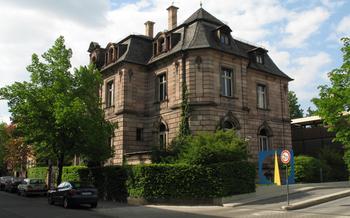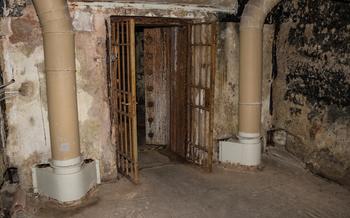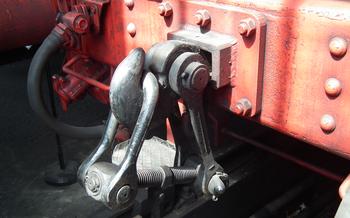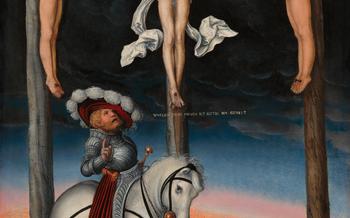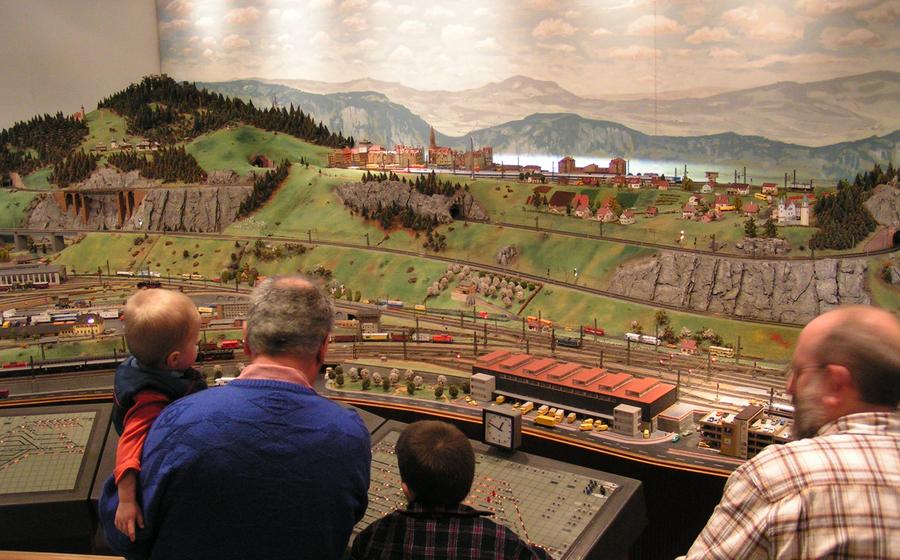
DB Museum (German Railway Museum)
- DB Museum: A Journey Through Time and Innovation
- Location and Accessibility
- Hours of Operation and Admission Fees
- Highlights of the Museum
- Interactive Experiences
- Historical Significance of Nuremberg in Railway Development
- The History of the DB Museum
- Special Events and Exhibitions
- Educational Programs and Workshops
- Tips for Planning Your Visit
- Must-See Exhibits for Railway Enthusiasts
- Family-Friendly Activities and Zones
- Accessibility for Visitors with Disabilities
- Insider Tip: Hidden Gems and Secret Spots
DB Museum: A Journey Through Time and Innovation
The DB Museum, also known as the German Railway Museum, is a captivating journey into the rich history and continuous innovation that has shaped the world of railways. Located in the heart of Nuremberg, this museum is a testament to the profound influence of German engineering and design on the development of railway transportation.
Established in 1899, the DB Museum boasts an extensive collection of locomotives, carriages, and railway artifacts that narrate the evolution of rail travel from its humble beginnings to the high-speed marvels of today. Interactive exhibits, immersive experiences, and educational programs bring the fascinating world of railways to life, making it an ideal destination for enthusiasts, history buffs, and families alike.
Location and Accessibility
The DB Museum is conveniently located in the heart of Nuremberg, a city steeped in history and culture. Situated at Lessingstraße 6, the museum is easy to find and accessible by various means of transportation. For those arriving by car, the museum offers ample parking spaces, ensuring a hassle-free visit. The museum's central location also makes it well-connected by public transportation. Multiple tram and bus lines stop nearby, providing visitors with convenient options to reach the museum. The museum is also wheelchair accessible, with ramps and elevators ensuring that all visitors can comfortably explore the exhibits. Comprehensive signage and multilingual assistance are available to cater to international visitors and ensure an inclusive experience for all.
Hours of Operation and Admission Fees
The DB Museum welcomes visitors from all over the world during its regular hours of operation. On weekdays, the museum is open from 9:00 AM to 5:00 PM, providing ample time to explore the extensive exhibits. During weekends and public holidays, the museum extends its hours from 10:00 AM to 6:00 PM, allowing visitors to immerse themselves in the world of railways even on their leisure days.
Admission fees are structured to cater to different visitor groups and budgets. Adults can purchase a standard ticket for €12, which grants them access to all exhibits and interactive experiences. Children aged 6 to 17 are eligible for a reduced fare of €6, making the museum an affordable family-friendly attraction. To encourage family bonding, a family ticket is available for €24, allowing two adults and up to three children to explore together.
The museum also offers a range of discounts and concessions to ensure accessibility and inclusivity. Visitors with disabilities and their companions receive a 50% discount on admission. Additionally, groups of 15 or more individuals are entitled to a special discounted rate, making the museum an ideal destination for school groups, tour operators, and corporate events.
Highlights of the Museum
The DB Museum boasts an impressive collection of iconic locomotives and trains that have played a pivotal role in German railway history. Visitors can marvel at the streamlined elegance of the DRG Class 01 steam locomotive, the powerful diesel-electric DB Class V 200, and the sleek ICE 3 high-speed train. These locomotives represent different eras of railway development and showcase the engineering prowess of German manufacturers.
In addition to locomotives, the museum houses a vast collection of historic railway artifacts, including uniforms, signal lanterns, and station signs. These artifacts provide a glimpse into the daily lives of railway workers and the evolution of railway operations over time.
Model railway enthusiasts will be delighted by the museum's extensive collection of model railway layouts. These intricate dioramas depict various railway scenes, from bustling stations to scenic landscapes. Visitors can marvel at the attention to detail and the craftsmanship that goes into creating these miniature worlds.
Finally, the museum features a series of thematic exhibitions that explore specific aspects of railway history and technology. These exhibitions cover topics such as the development of railway infrastructure, the role of railways in wartime, and the impact of railways on society and culture.
Interactive Experiences
The DB Museum offers a wide range of interactive experiences that bring the history of railways to life for visitors of all ages. Step into the shoes of a locomotive engineer in the realistic train simulators, where you can control the throttle, brakes, and signals to navigate through virtual landscapes. Immerse yourself in the world of virtual reality to explore the inner workings of a train engine or experience a thrilling ride on a high-speed train.
For hands-on enthusiasts, there are plenty of activities to engage with. Build your own model railway layout using the provided materials and let your imagination run wild. Participate in interactive workshops to learn about railway technology, signaling systems, and the history of train travel.
Guided tours led by knowledgeable museum staff provide an in-depth exploration of the exhibits, offering insights into the significance of various locomotives, artifacts, and railway innovations. These tours are available in English and German, ensuring that international visitors can also fully appreciate the museum's treasures.
Multimedia presentations scattered throughout the museum use audio-visual displays, touchscreens, and interactive panels to present information in an engaging and accessible way. These presentations cover a range of topics, from the evolution of train design to the impact of railways on society.
Historical Significance of Nuremberg in Railway Development
Nuremberg holds a significant place in the history of German railways. In the 19th century, the city became a pivotal hub for railway development and engineering. The establishment of the Ludwig Railway, connecting Nuremberg to Fürth, marked the beginning of a new era of transportation in the region. This railway line, built in 1835, was one of the earliest in Germany and played a crucial role in shaping the city's industrial growth and economic prosperity.
Nuremberg's contributions to railway technology and engineering were substantial. The city was home to several renowned locomotive manufacturers, including Maffei and MAN, who produced some of the most advanced locomotives of their time. These locomotives were instrumental in driving the expansion of the German railway network and revolutionizing transportation across the country.
The development of railways had a profound impact on Nuremberg's economy and culture. The city transformed into a major transportation center, attracting businesses and industries that relied on efficient transportation for their operations. The arrival of railways also facilitated cultural exchange and tourism, as people from different parts of Germany and beyond could now travel to Nuremberg more easily.
The History of the DB Museum
The DB Museum traces its roots back to the early 20th century when the German Railway Company (Deutsche Reichsbahn) established a small collection of historical railway vehicles and artifacts. In 1954, this collection was officially opened to the public as the "German Railway Museum" in Nuremberg.
Over the years, the museum underwent several expansions and renovations to accommodate its growing collection and to provide a more immersive and interactive experience for visitors. In 1996, the museum was relocated to its current location in the former Nuremberg freight yard, which allowed for a significant increase in exhibition space.
The museum's most recent renovation was completed in 2015, which included the addition of new galleries, interactive exhibits, and a modern visitor center. Today, the DB Museum stands as one of the most comprehensive and technologically advanced railway museums in the world, attracting visitors from around the globe.
Special Events and Exhibitions
The DB Museum enhances the visitor experience by hosting a variety of special events, exhibitions, and programs throughout the year. These events cater to diverse audiences, from railway enthusiasts and families to corporate groups and educational institutions.
Temporary exhibitions delving into specific railway-related themes are a highlight of the museum's offerings. These exhibitions showcase unique artifacts, historical documents, and interactive displays that provide a deeper understanding of various aspects of railway history, technology, and culture.
The museum also organizes events tailored for families, offering fun and educational activities for children of all ages. These events include themed weekends, interactive workshops, and hands-on activities that bring railway history to life for young visitors.
Corporate groups can arrange exclusive tours and workshops at the museum, providing a unique and memorable experience for team-building activities or corporate events. The museum's facilities can accommodate groups of various sizes and can be customized to meet specific requirements.
Seasonal festivals and celebrations add a festive touch to the museum's calendar. These events often feature live music, food stalls, and family-friendly activities, creating a lively and welcoming atmosphere for visitors.
Educational Programs and Workshops
The DB Museum offers a variety of educational programs and workshops designed to engage and inspire visitors of all ages. School groups and educational institutions can benefit from guided tours tailored to specific curriculum topics, such as the history of transportation, engineering, and industrialization.
Families can participate in hands-on workshops where children can build and operate their own model trains, explore the intricacies of railway signaling systems, and learn about the science behind train travel. These workshops provide a fun and interactive way for families to bond and learn together.
The museum also organizes summer camps and outreach initiatives to encourage young minds to pursue careers in railway engineering, transportation, and related fields. Through these programs, the DB Museum aims to foster a new generation of railway enthusiasts and innovators.
Tips for Planning Your Visit
To make the most of your visit to the DB Museum, here are some practical tips to keep in mind:
-
Recommended duration: Plan to spend at least 2-3 hours at the museum to fully explore the exhibits and interactive experiences.
-
Advance booking: Consider booking your tickets online in advance, especially during peak seasons or for special events, to avoid long queues. Guided tours can also be booked in advance to ensure a spot.
-
Best time to visit: To avoid crowds, aim to visit the museum during weekdays, particularly in the mornings. Weekends and school holidays tend to be busier.
-
Photography guidelines: Photography is generally allowed inside the museum, but flash photography and tripods are not permitted to protect the exhibits.
Must-See Exhibits for Railway Enthusiasts
For railway enthusiasts, the DB Museum offers a treasure trove of must-see exhibits. The "Locomotive Hall" is a highlight, showcasing a stunning collection of iconic locomotives from different eras. Visitors can marvel at the sleek design of the 01 series steam locomotive, the world's first operational high-speed train, the ICE 3, and the legendary electric locomotive, the E These locomotives represent milestones in railway history and offer insights into the evolution of engineering and technology.
Another must-see exhibit is the "Signal Box," which provides a fascinating glimpse into the world of railway signaling systems. Visitors can learn about the history of railway signals, the different types of signals used, and their importance in ensuring the safe operation of trains. Interactive displays allow visitors to experience firsthand how signals work and how they communicate with trains.
For model railway enthusiasts, the "Model Railway World" is an absolute must-see. This exhibit features a vast collection of miniature railway layouts, each meticulously crafted to recreate different railway scenes and landscapes. Visitors can admire the intricate details of these models, from the tiny locomotives and carriages to the miniature buildings and countryside. The "Model Railway World" offers a captivating experience that showcases the creativity and skill of model railway builders.
Finally, the "History of Railway Travel" exhibit takes visitors on a journey through the evolution of railway travel. From the early days of steam-powered trains to the modern era of high-speed rail, this exhibit explores the impact of railways on society, culture, and the economy. Visitors can learn about the challenges and triumphs of railway pioneers, the development of passenger services, and the role of railways in shaping the world we live in today.
Family-Friendly Activities and Zones
The DB Museum offers a range of family-friendly activities and zones to engage and entertain children of all ages. Interactive play areas, equipped with hands-on exhibits and educational games, provide a fun and educational experience for young visitors. The highlight for many is the "Kids' Railway," a miniature railway track where children can operate their own trains and learn about railway operations.
Family-friendly guided tours and workshops are also available, designed to capture the interest of both children and adults. These tours and workshops often include interactive elements, storytelling, and hands-on activities, making history come alive for the whole family. The museum also hosts special events and programs throughout the year, such as themed weekends, workshops, and holiday celebrations, which offer unique and memorable experiences for families.
Accessibility for Visitors with Disabilities
The DB Museum is committed to ensuring a welcoming and accessible environment for all visitors. Wheelchair users can easily navigate the museum's spacious galleries and exhibits, as ramps and elevators provide access to all levels. Assisted listening devices are available for guided tours, enhancing the auditory experience for visitors with hearing impairments. Visually impaired visitors can benefit from tactile exhibits and visual aids that provide detailed descriptions of locomotives and railway artifacts. Designated parking spaces are reserved near the museum entrance, ensuring convenient access for visitors with disabilities. With these accessibility features, the DB Museum strives to create an inclusive and enjoyable experience for everyone.
Insider Tip: Hidden Gems and Secret Spots
Beyond the main exhibits, the DB Museum holds a few hidden gems and secret spots worth exploring. One such gem is the concealed model railway layout tucked away in the museum's basement. This intricate layout, often overlooked by visitors, offers a mesmerizing glimpse into the world of miniature railways.
Another hidden gem is the museum's rooftop terrace, which provides breathtaking panoramic views of Nuremberg and the surrounding cityscape. Take a moment to soak in the scenery and appreciate the unique perspective it offers on the city's railway heritage.
Finally, keep an eye out for special events and workshops that may not be advertised on the museum's website. These exclusive events often offer unique insights into railway history and culture, providing an unforgettable experience for railway enthusiasts and casual visitors alike.


